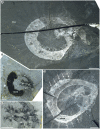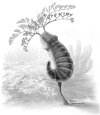Tentaculate fossils from the Cambrian of Canada (British Columbia) and China (Yunnan) interpreted as primitive deuterostomes
- PMID: 20221405
- PMCID: PMC2833208
- DOI: 10.1371/journal.pone.0009586
Tentaculate fossils from the Cambrian of Canada (British Columbia) and China (Yunnan) interpreted as primitive deuterostomes
Abstract
Molecular and morphological evidence unite the hemichordates and echinoderms as the Ambulacraria, but their earliest history remains almost entirely conjectural. This is on account of the morphological disparity of the ambulacrarians and a paucity of obvious stem-groups. We describe here a new taxon Herpetogaster collinsi gen. et sp. nov. from the Burgess Shale (Middle Cambrian) Lagerstätte. This soft-bodied vermiform animal has a pair of elongate dendritic oral tentacles, a flexible stolon with an attachment disc, and a re-curved trunk with at least 13 segments that is directed dextrally. A differentiated but un-looped gut is enclosed in a sac suspended by mesenteries. It consists of a short pharynx, a conspicuous lenticular stomach, followed by a narrow intestine sub-equal in length. This new taxon, together with the Lower Cambrian Phlogites and more intriguingly the hitherto enigmatic discoidal eldoniids (Cambrian-Devonian), form a distinctive clade (herein the cambroernids). Although one hypothesis of their relationships would look to the lophotrochozoans (specifically the entoprocts), we suggest that the evidence is more consistent with their being primitive deuterostomes, with specific comparisons being made to the pterobranch hemichordates and pre-radial echinoderms. On this basis some of the earliest ambulacrarians are interpreted as soft-bodied animals with a muscular stalk, and possessing prominent tentacles.
Conflict of interest statement
Figures






Similar articles
-
Tubicolous enteropneusts from the Cambrian period.Nature. 2013 Mar 28;495(7442):503-6. doi: 10.1038/nature12017. Epub 2013 Mar 13. Nature. 2013. PMID: 23485974
-
Cambrian Tentaculate Worms and the Origin of the Hemichordate Body Plan.Curr Biol. 2020 Nov 2;30(21):4238-4244.e1. doi: 10.1016/j.cub.2020.07.078. Epub 2020 Aug 27. Curr Biol. 2020. PMID: 32857969
-
A stem group echinoderm from the basal Cambrian of China and the origins of Ambulacraria.Nat Commun. 2019 Mar 25;10(1):1366. doi: 10.1038/s41467-019-09059-3. Nat Commun. 2019. PMID: 30911013 Free PMC article.
-
Extraordinary fossils reveal the nature of Cambrian life: a commentary on Whittington (1975) 'The enigmatic animal Opabinia regalis, Middle Cambrian, Burgess Shale, British Columbia'.Philos Trans R Soc Lond B Biol Sci. 2015 Apr 19;370(1666):20140313. doi: 10.1098/rstb.2014.0313. Philos Trans R Soc Lond B Biol Sci. 2015. PMID: 25750235 Free PMC article. Review.
-
The earliest history of the deuterostomes: the importance of the Chengjiang Fossil-Lagerstatte.Proc Biol Sci. 2010 Jan 22;277(1679):165-74. doi: 10.1098/rspb.2009.0646. Epub 2009 May 13. Proc Biol Sci. 2010. PMID: 19439437 Free PMC article. Review.
Cited by
-
Meiofaunal deuterostomes from the basal Cambrian of Shaanxi (China).Nature. 2017 Feb 9;542(7640):228-231. doi: 10.1038/nature21072. Epub 2017 Jan 30. Nature. 2017. PMID: 28135722
-
The Cambrian fossil Pikaia, and the origin of chordate somites.Evodevo. 2024 Feb 1;15(1):1. doi: 10.1186/s13227-024-00222-6. Evodevo. 2024. PMID: 38302988 Free PMC article.
-
Cambrian suspension-feeding tubicolous hemichordates.BMC Biol. 2016 Jul 7;14:56. doi: 10.1186/s12915-016-0271-4. BMC Biol. 2016. PMID: 27383414 Free PMC article.
-
Early Cambrian pentamerous cubozoan embryos from South China.PLoS One. 2013 Aug 12;8(8):e70741. doi: 10.1371/journal.pone.0070741. eCollection 2013. PLoS One. 2013. PMID: 23950993 Free PMC article.
-
A new species of the deuterostome Herpetogaster from the early Cambrian Chengjiang biota of South China.Naturwissenschaften. 2020 Aug 28;107(5):37. doi: 10.1007/s00114-020-01695-w. Naturwissenschaften. 2020. PMID: 32857275 Free PMC article.
References
-
- Budd GE, Jensen S. A critical reappraisal of the fossil record of the bilaterian phyla. Biological Reviews. 2000;75:253–295. - PubMed
-
- Gould SJ. The Burgess Shale and the Nature of History. New York: Norton; 1989. Wonderful Life.347
-
- Hou GX, Bergström J, Ma XY, Zhao J. The Lower Cambrian Phlogites Luo and Hu re-considered. GFF. 2006;128:47–51.
-
- Zhu MY, Zhao YL, Chen JY. Revision of the Cambrian discoidal animals Stellostomites eumorphus and Pararotadiscus guizhouensis from South China. Geobios. 2002;35:165–185.
Publication types
MeSH terms
LinkOut - more resources
Full Text Sources

